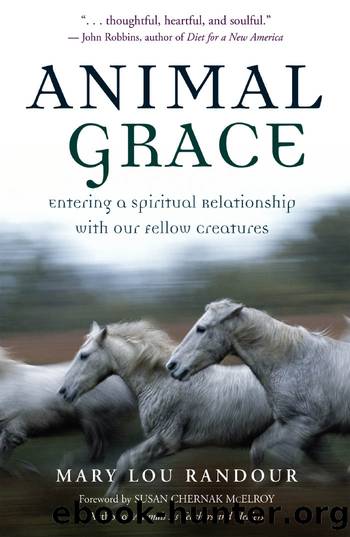Animal Grace by Mary Lou Randour

Author:Mary Lou Randour
Language: eng
Format: epub
ISBN: 9781577313229
Publisher: New World Library
Continuity of Existence
The reality of interdependence and seamless unity forms the basis for nonviolence. At the deepest level of our being, our true nature is being open to life, to consciousness, and to the inconceivable, transcendental reality that encompasses us, the deer, and the rest of nature belong.8 At this transcendental level of reality, no boundaries exist between us and the deer â or between any one of us and any others. All life is part of an ocean of consciousness. Individual waves take shape and disappear, only to reappear again in the mist of this vast ocean. While the individual waves appear to have a distinct shape and form, this is illusory; they are simply a manifestation of the all-encompassing, abiding ocean of consciousness. So it is with us. While we think we have a distinct shape and form â an âI-nessâ â at the most profound plane of existence we are consciousness, without name or form.
We are linked together in a world of reciprocal dependence, one in which other persons, animals, and elements coexist. Instead of organizing the natural world into discrete categories, the concept of ahimsa constructs a world characterized by a dynamic flow of interaction and interconnection. In his classic book on the basic philosophy of Buddhism, Walpola Rahula explains, âI am only relatively not you and you are only relatively not me.â9
We can distinguish an absolute reality of oneness from the practical, everyday reality in which we live. In this practical reality, we are trained to notice differences. An important aspect of a childâs cognitive maturation depends on making distinctions between categories and then organizing those categories into ever more complex networks and systems. At this practical level, the categories we use to organize differences are useful and necessary. At a spiritual level, however, the tendency to organize the world this way can be a hindrance. While we may be accustomed to focusing on the differences between us and deer and other animals, these distinctions, at an underlying level of reality, are illusions. If we only take into account that which separates and distinguishes us from one another, we miss the possibility of experiencing the transcendental reality that surrounds our being. The practitioner devotes herself to trying to enact ahimsa in the practical reality in which we live â that is, to catch glimpses of the absolute reality in the midst of our everyday lives.
Those who spoke in favor of the slaughter saw the deer as nuisances and pests, as âthingsâ that needed to be disposed of. Often they spoke of the deer with great vehemence and animosity. Perhaps some had become desensitized to violence, which blunted their ability to respond to the deer with empathy. All of us are vulnerable to this kind of deadening of our senses. By practicing ahimsa we train ourselves to open to the perspectives and situations of others; ahimsa is our best antidote for lapsing into insensitivity.
The yawning, unbridgeable gap was obvious â they saw little or no connection between themselves and the deer.
Download
This site does not store any files on its server. We only index and link to content provided by other sites. Please contact the content providers to delete copyright contents if any and email us, we'll remove relevant links or contents immediately.
The Lonely City by Olivia Laing(4768)
Animal Frequency by Melissa Alvarez(4424)
All Creatures Great and Small by James Herriot(4267)
Walking by Henry David Thoreau(3921)
Exit West by Mohsin Hamid(3791)
Origin Story: A Big History of Everything by David Christian(3665)
COSMOS by Carl Sagan(3584)
How to Read Water: Clues and Patterns from Puddles to the Sea (Natural Navigation) by Tristan Gooley(3430)
Hedgerow by John Wright(3313)
How to Read Nature by Tristan Gooley(3289)
The Inner Life of Animals by Peter Wohlleben(3282)
How to Do Nothing by Jenny Odell(3263)
Project Animal Farm: An Accidental Journey into the Secret World of Farming and the Truth About Our Food by Sonia Faruqi(3189)
Origin Story by David Christian(3169)
Water by Ian Miller(3154)
A Forest Journey by John Perlin(3042)
The Plant Messiah by Carlos Magdalena(2900)
A Wilder Time by William E. Glassley(2833)
Forests: A Very Short Introduction by Jaboury Ghazoul(2814)
